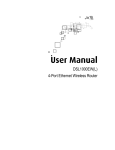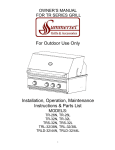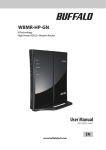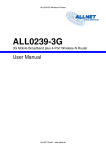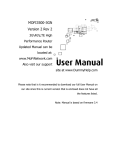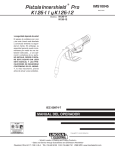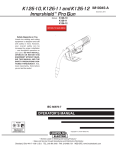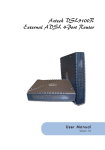Download Aztech DSL1000EW L User manual
Transcript
DSL1000EW(L) 4-Port ADSL2+ Wireless-G Modem Router User Manual © Copyright 2011 All rights reserved. No part of this document may be reproduced, republished, or retransmitted in any form or by any means whatsoever, whether electronically or mechanically, including, but not limited to, by way of photocopying, recording, information recording, or through retrieval systems without the express written permission. We reserve the right to revise this document at any time without the obligation to notify any person and/or entity. All other company or product names mentioned are used for identification purposes only and may be trademarks of their respective owners. LIMITATION OF LIABILITY AND DAMAGES THE PRODUCT AND THE SOFTWARES WITHIN ARE PROVIDED "AS IS," BASIS. THE MANUFACTURER AND MANUFACTURER’S RESELLERS (COLLECTIVELY REFERRED TO AS “THE SELLERS”) DISCLAIM ALL WARRANTIES, EXPRESS, IMPLIED OR STATUTORY, INCLUDING WITHOUT LIMITATION THE IMPLIED WARRANTIES OF NONINFRINGEMENT, MERCHANTABILITY OR FITNESS FOR A PARTICULAR PURPOSE, OR ANY WARRANTIES ARISING FROM COURSE OF DEALING, COURSE OF PERFORMANCE, OR USAGE OF TRADE. IN NO EVENT WILL THE SELLERS BE LIABLE FOR DAMAGES OR LOSS, INCLUDING BUT NOT LIMITED TO DIRECT, INDIRECT, SPECIAL WILLFUL, PUNITIVE, INCIDENTAL, EXEMPLARY, OR CONSEQUENTIAL, DAMAGES, DAMAGES FOR LOSS OF BUSINESS PROFITS, OR DAMAGES FOR LOSS OF BUSINESS OF ANY CUSTOMER OR ANY THIRD PARTY ARISING OUT OF THE USE OR THE INABILITY TO USE THE PRODUCT OR THE SOFTWARES, INCLUDING BUT NOT LIMITED TO THOSE RESULTING FROM DEFECTS IN THE PRODUCT OR SOFTWARE OR DOCUMENTATION, OR LOSS OR INACCURACY OF DATA OF ANY KIND, WHETHER BASED ON CONTRACT, TORT OR ANY OTHER LEGAL THEORY, EVEN IF THE PARTIES HAVE BEEN ADVISED OF THE POSSIBILITY OF SUCH DAMAGES. THE ENTIRE RISK AS TO THE RESULTS AND PERFORMANCE OF THE PRODUCT OR ITS SOFTWARE IS ASSUMED BY CUSTOMER. BECAUSE SOME STATES DO NOT ALLOW THE EXCLUSION OR LIMITATION OF LIABLITY FOR DAMAGES, THE ABOVE LIMITATION MAY NOT APPLY TO THE PARTIES. IN NO EVENT WILL THE SELLERS’ TOTAL CUMULATIVE LIABILITY OF EACH AND EVERY KIND IN RELATION TO THE PRODUCT OR ITS SOFTWARE EXCEED THE AMOUNT PAID BY CUSTOMER FOR THE PRODUCT. Page 2 of 50 User Manual Contents About the Router ........................................................................................................ 5 Firmware Features....................................................................................... 6 Requirements .............................................................................................. 9 Package Contents ........................................................................................ 9 Device Design ............................................................................................ 10 Front Panel ..................................................................................................................10 Back Panel ...................................................................................................................11 Power Supply ..............................................................................................................11 Getting Started ......................................................................................................... 12 Planning Your Network ............................................................................. 13 Remove or Disable Conflicts ...................................................................... 14 Internet Sharing, Proxy, and Security Applications ................................................14 Configuring TCP/IP Settings.......................................................................................15 Configuring Internet Properties.................................................................................15 Removing Temporary Internet Files .........................................................................16 Setup the Device ....................................................................................... 17 Wall Mount Feature ....................................................................................................18 Connecting to the Internet ........................................................................ 19 Connecting Via Quick Setup .......................................................................................19 Basic Mode ............................................................................................................... 20 Accessing the Basic Mode Web Interface................................................... 20 Menus ........................................................................................................ 21 Home ............................................................................................................................21 Status............................................................................................................................23 Diagnostics...................................................................................................................25 Wireless ........................................................................................................................27 Advanced Mode ........................................................................................................ 29 Accessing the Advanced Web Interface ..................................................... 29 Menus ........................................................................................................ 30 WAN..............................................................................................................................30 LAN ...............................................................................................................................33 Page 3 of 50 User Manual Applications .................................................................................................................35 Security ........................................................................................................................42 Admin ...........................................................................................................................45 Page 4 of 50 User Manual About the Router Your router offers an easy way of integrating your computer and other network devices into a single network. Here are some of the benefits you can obtain from using the router in your home or office: Integrated Modem Feature Your router is an ideal solution for high speed Internet connectivity. It is capable of handling the fastest data transfer speed from your Internet provider and sharing this within your local network devices. Top Notch Security Your router utilizes built-in firewall security to block service attacks. For added flexibility, it can be modified to allow specific applications to pass through while blocking intrusive threats at the same time. Intuitive User Interface Applying changes on the router settings can be done easily using a Web browser. The router uses a simplified user interface that allows you to apply the configurations you want for the various features of the router. Your router will serve as the central figure in establishing your local area network (LAN) by using a combination of hardware and software. The hardware includes the cables, wireless access points, and Ethernet ports that create the path to connect your devices. The software part includes the applications that manage the flow of information in these devices. You can complete the basic installation and Internet connection within 8 minutes. Some more time is needed if you intend to utilize more advanced functions but it can be worth it. Advanced features like port forwarding will help you create your own web server to store your Web site, Dynamic DNS allows you to access your network from the Internet, and remote access enables you to configure your router settings from different locations. Once installation is complete, it will be much more easier for you to enjoy voice communication, high speed Internet, and data/audio/video sharing within your network. Page 5 of 50 User Manual Firmware Features ADSL Support ANSI T1.413 issue 2, ITU-T G.992.1 (G.dmt) and G.992.2 (G.lite) compliant G.992.3 (ADSL2), G.992.5 (ADSL2+), RE-ADSL Ready ATM Layer with Traffic shaping QoS Support (UBR, CBR, VBR-rt, VBR-nrt) AAL ATM Attributes - AAL5 Multiple PVC up to 8 support Spectral compatibility with POTS F4 & F5 OAM Loopback/Send and Receive Annex A, Annex B, Annex M Support TR048 and TR067 compliant PVC support Encapsulation Support RFC2684 Bridge and Routed LLC and VC Mux support RFC2364 PPPoA Client support RFC2516 PPPoE Client support RFC2225/RFC1577 Classical IP Support Transparent Bridge Support PAP/CHAP/MS-CHAP for Password Authentication Support Network Support Static IP, Dynamic RIP v1/v2 routing support IP/TCP/UDP/ICMP/ARP Application Support Network Address Translation (NAT) PVC to VLAN Mapping Port Forwarding/Triggering Easy setup of Port Forwarding rules for popular Games/Application NAT Application Level Gateway for popular applications DHCP Server/client DNS Relay Agent DMZ support Page 6 of 50 User Manual SIP ALG (Application Layer Gateway) support Multiple Sessions IP Sec and PPTP/L2TP VPN pass through support PPP Always on PPP Dial on Demand with configurable timeout Universal Plug and Play Support DDNS (Dynamic DNS) Support IGMP Proxy Support (IGMP v1 and v2) SNTP Support QoS Support (DSCP, TOS), including Diffserv, IEEE802.1p - Priority bit, IEEE802.1q VLAN triggering WLAN Support Support Wireless on Motherboard (WOMBO) IEEE 802.11, 802.11b and 802.11g compliant Supports 802.11b, 802.11g simultaneously Transmit output power up to 20dBm (standard) Conforms to Wireless Ethernet Compatibility Alliance (WECA) Wireless Fidelity (Witm Fi ) Standard Support seamless WLAN roaming Frequency Band: - 2412 MHz - 2462 MHz (North America/FCC) - 2412 MHz - 2472 MHz (ETSI/Europe) - 2412 MHz - 2484 MHz (Japan) - 2457 MHz - 2472 MHz (France) - 2457 MHz - 2462 MHz (Spain) Support Direct Sequence Spread Spectrum (DSSS) technology Modulation: OFDM with BPSK, QPSK, 16QAM, 64QAM, DBPSK, DQPSK, CCK Wireless Media Access Protocol- CSMA/CA with ACK 64/128 WEP Encryption WPA/WPA2 Support MAC filtering Support Dynamic Rate Scaling from 54, 48, 36, 24, 12, 11, 9, 6, 5.5, 2, 1 Mb/s Operating Range of up to 300 feet (Open Air) Page 7 of 50 User Manual Management Support Web Based HTTP management GUI Web Based Firmware Upgrade (Local) Soft Factory Reset Button via Web GUI Diagnostic Test (DSL, OAM (ADSL), Network (ADSL), Ping Test) TR068 - WAN Access Telnet with CLI (Read and Write) configuration Syslog Support Firmware upgradeable for future feature enhancement Quick firmware upgrade button (depopulation option) TR-069 Compliant (optional) SNMP v1 and v2 (optional) SSH Support (optional) Security Support NAT for basic Firewall support Packet Filtering Firewall Support Stateful Packet Inspection Support Protection against Denial of Service attacks Password Authentication to Modem Parental Control Real-Time Attack and Alert Logs (optional) Page 8 of 50 User Manual Requirements Your computer must meet the following minimum requirements. Any operating system can be used Web Browser CDROM drive 233MHz processor Ethernet network adapter An active DSL Internet account Package Contents Package contents are listed below. For any missing items, please contact your dealer immediately. Product contents vary for different models. Router Ethernet cable Telephone cable POTS Splitter (optional) 12V 1.0A DC Power Adapter Easy Start Guide Resource CD Page 9 of 50 User Manual Device Design Front Panel Label 1 2 3 4 5 POWER ETHERNET LAN WIRELESS Icon Action Description Off No power is supplied to the device Steady green Connected to an AC power supply Steady red Error on the device Off No Ethernet connection Steady green Connected to an Ethernet port Blinking green Transmitting/Receiving data Off Wireless interface disabled Steady green Wireless Interface enabled Blinking green Transmitting/Receiving data Blinking green Establishing or No DSL signal Steady green DSL signal is established Off No connection to the Internet Steady green Internet connection established Blinking green Transmitting/Receiving data Steady red PPP authentication failed DSL INTERNET Page 10 of 50 User Manual Back Panel Label Description 6 BROADBAND Connecting the modem to an ADSL line 7 ETHERNET 11-4 Connecting computers and other Ethernet devices 8 RESET To reset the modem to the factory default configuration 9 DC In 12V 1.0A DC Input port 10 POWER Power ON/OFF button 11 Antenna Sending/receiving wireless signals Power Supply MANUFACTURER : Aztech MODEL : SWM11-12120-EU/UK INPUT : 100-240V~0.4A 50-60Hz OUTPUT : 12.0V 1.00A Page 11 of 50 User Manual Getting Started Setting up the device is easy. The flowchart below provides an outline of the steps needed to complete the installation. Brief descriptions appear beside each step. Detailed instructions are provided in the subsequent pages. Plan your Network Remove/Disable Conflicts You may need to check some Setup the Router Connect the telephone cables, Connect to the Internet Web Interface Use Quick Setup Ready to Use Page 12 of 50 setting or disable some application before installation. Ethernet cables, and power adaptor. Use the Quick Start Web GUI to setup your PPPoE connection. User Manual Planning Your Network Before moving ahead to setup your network, it is a good idea to draw out a network diagram to help identify your network devices and plan out how to connect these devices. The illustration below is an example of a network diagram Each port in the router can be used for different connections. For example: • Ethernet 1 – Dad’s computer • Ethernet 2 – Mom’s computer • Ethernet 3 – Game Console • Ethernet 4 – Network Printer To create a network diagram: • For wireless devices, identify the wireless devices you want to include in the network • For wired devices, identify which router port you want to use for each device. Page 13 of 50 User Manual Remove or Disable Conflicts To make sure the router installation moves on smoothly, you need to remove or disable conflicts that may interfere the installation. Probable conflicts may include: Internet sharing applications Proxy software Security software TCP/IP settings Internet properties Temporary Internet files Internet Sharing, Proxy, and Security Applications Internet sharing, proxy software, and firewall applications may interfere with the router installation. These should be removed or disabled before start the installation. If you have any of the following or similar applications installed on your computer, remove or disable them according to the manufacturer’s instructions. Internet Sharing Applications Proxy Software Security Security Software Microsoft Internet Sharing WinGate Symantec WinProxy Zone Alarm Page 14 of 50 User Manual Configuring TCP/IP Settings Check if your computer uses the default TCP/IP settings. To check the TCP/IP properties: 1. Select Start > Run. This opens the Run dialog box. 2. Enter control ncpa.cpl and then click OK. This opens the Network Connections in your computer. 3. Right-click LAN and then select Properties. This opens the Local Area Connection Properties dialog box. 4. Select Internet Protocol (TCP/IP) and then click Properties. This opens the Internet Protocol (TCP/IP) dialog box. 5. Select Obtain an IP address automatically. 6. Click OK to close the Internet Protocol (TCP/IP) dialog box. 7. Click OK to close the Local Area Connection Properties dialog box. Configuring Internet Properties To set the Internet Properties: 1. Select Start > Run. This opens the Run dialog box. 2. Enter control inetcpl.cpl and then click OK. This opens Internet Properties. 3. Click Connections tab. 4. In the Dial-up and Virtual Private Network settings pane, select Never dial a connection. 5. Click OK to close Internet Properties. Page 15 of 50 User Manual Removing Temporary Internet Files Temporary Internet files are files from Web sites that are stored in your computer. Delete these files to clean the cache and remove footprints left by the Web pages you visited. To remove temporary Internet files: 1. Select Start > Run. This opens the Run dialog box. 2. Enter control and then click OK. This opens Control Panel. 3. Double-click Internet Options. This opens Internet Options. 4. In the Temporary Internet Files pane, click Delete Cookies. 5. Click Delete Files. 6. Click OK to close Internet Properties. Page 16 of 50 User Manual Setup the Device When installing the router, find an area where there are enough electrical outlets for the router, the main computer, and your other computer devices. To setup the router: 1. Plug one end of the Ethernet cable from the router’s ETHERNET port and then plug the other end into the Ethernet port in your computer. 2. If you have another device you need to connect through wire into the router, use another piece of Ethernet cable. Plug one end of the Ethernet cable from the computer’s Ethernet port and then plug the other end into an available Ethernet port in the router. 3. Plug one end of the telephone cable from the POTS Splitter’s ADSL port and then plug the other end into the router’s DSL port. POTS Splitter Your phone line carries with it both phone calls and Internet signals. When you are using the Internet, the connection produces high-pitched tones that can affect your voice calls when using the phone. Installing a Plain Old Telephone Service (POTS) splitter separates the two signals and eliminates the noise. To setup a telephone on the POTS Splitter: a. Locate the phone jack in your house. b. Insert the POTS Splitter into the phone jack. c. Plug one end of the telephone cable from the POTS Splitter’s TEL port and then plug the other end into the telephone. Page 17 of 50 User Manual 4. Connect the power adapter from the router’s 12V 1.0A DC port into the electrical outlet. 5. Press ON. Wall Mount Feature The Aztech DSL1000EW(L) provides a wall-mount feature to affix the router to a wall. To setup the router to a wall-mount: 1. Identify the wall where you would like to mount the router. Ensure that it is sturdy and within reach of a power outlet and your telephone line socket for the DSL connection. 2. Make a mark for 2 holes 127mm apart on the wall and drill the screws leaving 5mm of the head exposed. 3. Once the screws are in place, you may latch the wall mount sockets on the bottom of your router until it is firmly attached. NOTE: NOTE: Adjust the screws if you are unable to latch the router. Page 18 of 50 User Manual Connecting to the Internet You can use the Web Interface to setup your Internet connection. Connecting Via Quick Setup To connect to the Internet via the User mode GUI: 1. Launch the web browser and input 192.168.1.1 on the address bar. 2. Input admin for username and input admin for password. Click the Login button. 3. Click Quick Setup. 4. Enter the ADSL WAN connection settings. a. Select a Connection Type b. Enter the PPP Username and Password 5. Click the Apply button to commit the settings. Page 19 of 50 User Manual Basic Mode Basic Mode provides configuration options for wireless router functions, Status, and Diagnostic features. Accessing the Basic Mode Web Interface To access the Basic Mode Web Interface: 1. Launch your web browser. 2. Input 192.168.1.1 on the address bar and press Enter. 3. There will be an authentication request where you need to key in a username and password. Default Username: admin | Password: admin 4. Click Login 5. Select the menu icon from the top panel Page 20 of 50 User Manual Menus The Basic Mode Web User Interface includes the following menus: Home Status Diagnostics Wireless Home Main Displays the summary and provides an overview of the operating parameters used in your device. Page 21 of 50 User Manual Quick Setup You can use Quick Setup to configure your Internet connection. PPPoE/PPPoA - Select PPPoE or PPPoA to enter the username and the password provided by you ISP. DHCP - Select DHCP for the modem router to automatically acquire IP information from the server. Static IP - Select Static IP to manually set the IP address, subnet mask, gateway and so on. Bridge - Select Bridge if you have another device behind the modem router to establish the Internet connection such as another router or a PPP dialer on your PC. Page 22 of 50 User Manual Status Device Info Device info menu displays different information about the device and current ADSL connection status such as total System Uptime and DSL Uptime. LAN LAN menu displays the device IP address, DHCP server parameters and a list of DHCP clients connected to the modem router. Page 23 of 50 User Manual Wireless Wireless menu displays the current wireless operating parameters of the modem router. ADSL ADSL menu displays the complete ADSL connection status of the modem router. Page 24 of 50 User Manual Statistics Statistics menu displays the complete connection statistic information for each interface of the modem router. Diagnostics Diagnostics Diagnostic menu tests all the interfaces of the modem router including the DSL and Internet connection. Page 25 of 50 User Manual Network Tools Network tools allow the user to test the Internet connection by using a ping command to an IP address or web URL. Page 26 of 50 User Manual Wireless Settings This page allows you to configure basic features of the wireless LAN interface. You can enable or disable the wireless LAN interface, hide the network from active scans, set the wireless network name (also known as SSID), restrict the channel set based on country requirements, and all other configurations relating to the wireless LAN interface. Click Apply to commit the wireless settings. Security This page allows you to set the network authentication method, selecting data encryption, specify whether a network key is required to authenticate to this wireless network and specify the encryption strength. Click "Apply" to commit wireless security settings. Page 27 of 50 User Manual Station List This page displays the wireless clients connected to the modem router. Access Control List This page allows you to set a filter to Allow or Deny specific wireless clients by entering the MAC address and selecting the Access Control List mode. Page 28 of 50 User Manual Advanced Mode Advanced Mode provides configuration options for other router functions. Accessing the Advanced Web Interface To access the Advanced Web Interface: 1. Launch your web browser. 2. Input 192.168.1.1 on the address bar and press Enter. 3. There will be an authentication request where you need to key in a username and password. Default Username: admin | Password: admin 4. Click Login 5. Click Advanced Mode Page 29 of 50 User Manual Menus The Web User Interface includes the following menus: WAN LAN Applications Security Admin WAN ATM/ETH Settings Configure the ATM/ETH parameters from this page. Page 30 of 50 User Manual Internet The initial page will show all the settings of your existing WAN connection configured on your router. You have an option to Add and Edit WAN interface configurations. To add a WAN interface: 1. Select the WAN Connection Type from the Quick Setup page 2. Enter the information for each specific field to configure the Internet connection 3. Click the Add button to commit the settings To edit an existing WAN interface: 1. Select the WAN interface you wish to edit and click the Edit button 2. Make the necessary amendments 3. Click the Add button to commit the settings To delete an existing WAN interface: 1. Select the WAN interface you wish to delete 2. Click the Remove button Page 31 of 50 User Manual ADSL Settings The DSL page allows you to select the modulation, the phone line pair and the capability. UPnP This page allows you to enable/disable UPnP feature on the modem-router. Page 32 of 50 User Manual LAN Local Configure the DSL Router IP Address and Subnet Mask for LAN interface. You may also configure the DHCP server settings of your router. MAC-IP Reservation The initial page allows you to assign a specific IP address to a specific device by entering its MAC address. Page 33 of 50 User Manual To manually reserve a LAN IP address: 1. Key in the PC’s MAC address 2. Key in the LAN IP Address you want to assign 3. Click the Add button DNS DNS (Domain Name System) is an Internet service that translates domain names into IP addresses. Because domain names are alphabetic, they are easier to remember. However, the Internet is based on IP addresses. Therefore, each time you type a domain name, a DNS service must translate the name into the corresponding IP address. For example, the domain name www.example.com might translate to 198.105.232.4. The DNS system consists of a network of DNS servers. If one DNS server does not know how to translate a particular domain name, it asks another one and so on until the correct IP address is returned. Page 34 of 50 User Manual If you select DNS server from available WAN interfaces checkbox, the router will receive and use the DNS Server assigned by your ISP. To use your preferred DNS servers, select Use the following static DNS IP address checkbox and key in the IP address of your Primary DSN server. Adding a Secondary DNS server is optional. The DNS Proxy Configuration page allows you to enable and specify a DNS proxy name. Applications Port Forwarding Port Forwarding allows you to direct incoming traffic from the Internet to a specific computer in your local network. A maximum 12 entries can be configured. Page 35 of 50 User Manual As an example, to setup an ftp server on a computer using 192.168.1.2 as its IP Address, select FTP as Service and enter 192.168.1.2 as the Server IP Address. Otherwise if the service you want to setup is not available from the Select a Service drop-down list, you can define your own Port Forwarding rule. DMZ Host If a computer is assigned as a DMZ Host, it will receive all the data from the Internet that do not belong to the list of applications configured in Port Forwarding. Enter the LAN IP address of the PC you wish to set as DMZ Host in the provided box. If you need to disable the DMZ Host, just click the remove button. Note: DMZ exposes your computer to the Internet and will be vulnerable to malicious attacks. Port Triggering Some applications require that the specific ports in the router’s firewall be opened for access by the remote parties. A maximum of 8 entries can be configured. Page 36 of 50 User Manual To setup Port Triggering: For instance, an application uses port 25 for requests and port 113 for replies. If a computer on the LAN connects to port 25 on a remote server hosting this application, using Port Triggering on the router, incoming connections to port 113 (from the remote server) could be redirected to the PC which initiated the request. DDNS The router offers a Dynamic Domain Name System (DDNS) feature. DDNS lets you assign a fixed host and domain name to a dynamic Internet IP Address. It is useful when you are hosting your own website, FTP server, or other server behind the router. Before using this feature, you need to sign up for DDNS service providers. Using DynDNS.org Key in the following parameters: Service provider Select www.DynDNS.org. My Hostname Enter the hostname. DynDNS Settings Enter your dyndns.org Username and password. Page 37 of 50 User Manual Route If your LAN consists of multiple subnets and you want to manually define the data transmitting paths, Static Route is to be used. The key settings for adding a new Static Route are explained: Destination Network Address Enter the network address to which the data packets are to be sent. Subnet Mask Enter the subnet mask for this destination. Use Gateway IP Address If you wish to use a specific gateway to reach the destination network, select this checkbox and then enter the IP address of the gateway. Use Interface If you wish to use a particular WAN interface, select the checkbox and select the interface. Click Save/Apply to take effect the settings. To delete the entry from the routing table list, click its corresponding Delete button. Page 38 of 50 User Manual RIP NOTE: RIP CANNOT BE CONFIGURED on the WAN interface that has NAT enabled (such as PPPoE). To activate RIP for the WAN Interface, select the desired RIP version and operation and place a check in the 'Enabled' checkbox. To stop RIP on the WAN Interface, uncheck the 'Enabled' checkbox. Click the 'Apply/Save' button to star/stop RIP and save the configuration. Quality of Service QoS gives you the capability to specify the level of quality to be provided for specific applications. By default, QoS is not enabled. Page 39 of 50 User Manual Queue Config The screen allows you to configure a QoS queue entry and assign it to a specific network interface. Each of the queues can be configured for a specific precedence. The queue entry configured here will be used by the classifier to place ingress packets appropriately. Note: Lower integer values for precedence imply higher priority for this queue relative to others Click 'Apply/Save' to save and activate the queue. Click Add to create a QoS Queue Configuration. QoS Classification You can add or remove QoS Classification rules. The screen creates a traffic class rule to classify the upstream traffic, assign queue which defines the precedence and the interface and optionally overwrite the IP header DSCP byte. A rule consists of a class name and at least one condition below. All of the specified conditions in this classification rule must be satisfied for the rule to take effect. Click 'Save/Apply' to save and activate the rule. Click Add to create a Network Traffic Class Rule. Port Mapping Port mapping allows you to create groups composed of the various interfaces available in your router. Port mapping supports multiple ports to PVC and bridging groups. Each group will perform as an independent network. To support this feature, you must create mapping groups with appropriate LAN and WAN interfaces using the Add button. The Remove button will remove the grouping and add the ungrouped interfaces to the Default group. Only the default group has IP interface. Page 40 of 50 User Manual To create a new interface group: 1. Enter the Group name and the group name must be unique and select either 2. (dynamic) or 3. (static) below: 2. If you like to automatically add LAN clients to a WAN Interface in the new group add the DHCP vendor ID string. By configuring a DHCP vendor ID string any DHCP client request with the specified vendor ID (DHCP option 60) will be denied an IP address from the local DHCP server. 3. Select interfaces from the available interface list and add it to the grouped interface list using the arrow buttons to create the required mapping of the ports. Note that these clients may obtain public IP addresses 4. Click Save/Apply button to make the changes effective immediately IMPORTANT: If a vendor ID is configured for a specific client device please REBOOT the client device attached to the modem to allow it to obtain an appropriate IP address. Page 41 of 50 User Manual Security IP Filtering The router supports IP Filtering, which allows you to easily set up rules to control incoming and outgoing Internet traffic. The router provides two types of IP filtering: Outgoing IP Filtering and Incoming IP Filtering. Choose IP from the Rule Type drop down box to configure IP Filtering. Outgoing IP Filtering By default, the router allows all outgoing Internet traffic from the LAN but by setting up Outgoing IP Filtering rules, you can block some users and/or applications from accessing the Internet. To create a new outgoing IP filter, click Add. The Add IP Filter-Outgoing page will be displayed. Incoming IP Filtering By default, when NAT is enabled, all incoming IP traffic from WAN is blocked except for responses to requests from the LAN. However, some incoming traffic from the Internet can be accepted by setting up Incoming IP Filtering rules. Page 42 of 50 User Manual To create a new IP filter rule, click Add. The Add IP Filter-Incoming page will be displayed. Key in the following parameters: Filter Name Key in the name of the filter rule. Protocol Select the IP protocol to block. Source IP Address/Subnet Mask Enter the IP address of the PC on the LAN to block. Source Port Enter the port number used by the application to block. Destination IP Address/Subnet Mask Enter the IP address of the remote server to which connection should be blocked. Destination Port Enter the destination port number used by the application to block. Click Save/Apply to take effect the settings. The new rule will then be displayed in the Outgoing IP Filtering table list. To delete the rule, click Remove checkbox next to the selected rule, and click Remove. Page 43 of 50 User Manual MAC Filter The router supports MAC Filter, which allows you to easily set up rules to control incoming and outgoing frames for Bridge interface. Parental Control Parental Control allows you to apply router access restrictions among LAN devices within specific times in a day. A maximum of 16 restriction rules can be created. Page 44 of 50 User Manual To add restrictions, go to Time Restriction and click the Add button. This opens the Access Time Restriction page. Key in the necessary information and click the Apply/Save button. To delete a restriction, click Remove checkbox next to the selected restriction, and click Remove. Key in the following parameters: User Name Enter a descriptive name for the restriction. Browser’s MAC Address or Other MAC Address Enter the device MAC Address. Days of the week Click to select the days on which to apply the restriction. Start Blocking Time (hh:mm) Enter the time when the restriction will be enabled (00:00 to 23:59). End Blocking Time (hh:mm) Enter the time when the restriction will be disabled (00:00 to 23:59). Admin Settings When it comes to managing the settings that you have executed to the router, you can choose to: Backup the settings as a configuration file stored onto your PC Update the current settings from a previously saved configuration file Erase the current settings and restore the default factory values Page 45 of 50 User Manual Backup To backup the settings as a configuration file saved on your PC, click Backup Settings. Select the folder where you want to save the file and key in the file name under which you want to save the settings. Update To import a previously saved configuration file from your PC and update the settings of your router, click Browse to locate the binary (.BIN or .IMG) upgrade file. Then click Update Settings. Restore Default To restore your router to its factory default settings, click Restore Default Settings. When prompted, click OK. Upon clicking OK, you will be prompted to follow the instruction as shown below. Reboot This feature allows the router to enable new network configuration to take effect or to clear problems with the router’s network connection. Page 46 of 50 User Manual Password Settings When you configure the router through an Internet browser, the system requires you to enter your user name and password to validate your access permission. By default, the Username is set to “admin” and the Password to “admin”. The user name "admin" has unrestricted access to change and view configuration of your DSL Router. The user name "support" is used to allow an ISP technician to access your DSL Router for maintenance and to run diagnostics. The user name "user" can access the DSL Router, view configuration settings and statistics, as well as, update the router's software. Use the fields to enter up to 16 characters and click "Apply" to change or create passwords. Note: Password cannot contain a space. Page 47 of 50 User Manual Firmware Upgrade Allow you to update the firmware of your router. To Update the router’s firmware: 1. Click Browse 2. Choose the firmware file and click OK 3. Click the Upgrade button Internet Time Enable Internet Time to automatically synchronize your time with a time server. Page 48 of 50 User Manual System Log This feature provides you a comprehensive list of log entries reporting events which you have configured for viewing. To view the log, click View System Log. Page 49 of 50 User Manual Safety Precautions Do not open, service, or change any component. Only qualified technical specialists are allowed to service the equipment. Observe safety precautions to avoid electric shock Check voltage before connecting to the power supply. Connecting to the wrong voltage will damage the equipment. Page 50 of 50


















































